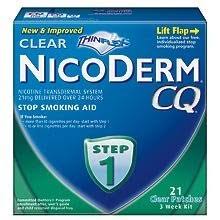NICOTINE REPLACEMENT THERAPIES
Today we’ll see what are considered the most used methods to stop smoking. The description of the products is as published by their manufacturers.


NAME: Chewing gum (several brands)
HOW IT WORKS: The nicotine contained in the product penetrates the body via the mouth tissue
HANDLES WITHDRAWAL SYMPTOMS: Yes, partially, depending on the frequency of use of the product
HANDLES HABITS: No
DURATION OF TREATMENT: 7 weeks
REAL SUPPORT AND FOLLOW-UP: Some manufacturers offer online
SUBSTITUTES FOR ANOTHER ADDICTION (WEIGHT GAIN): It doesn’t offer support to avoid substituting tobacco with food or any other addiction. They do not consider the fact.
PROBABLE EFFECTS AND RISKS: This material may produce stimulation to the central nervous system, and skin reactions on contact
RISKY DURING PREGNANCY AND BREASTFEEDING: Unknown to the manufacturer.
INFORMS CONSUMERS ABOUT ITS RISKS: Information is scarce and in very small print. Very often the prescriber doesn’t make sure that the patient knows and understands the risks.
ALTERS BRAIN CHEMISTRY: Yes, it is nicotine
PROMOTES COGNITIVE CAPACITY: No


NAME: TRANSDERMAL PATCH (Several brands)
HOW IT WORKS: The “Therapeutic Nicotine” contained in the product is released along 24 hours, and penetrates the body via the skin
HANDLES WITHDRAWAL SYMPTOMS: It reduces them
HANDLES HABITS: No
DURATION OF TREATMENT: 10 to 12 weeks
REAL SUPPORT AND FOLLOW-UP: Online
SUBSTITUTES FOR ANOTHER ADDICTION (WEIGHT GAIN): It doesn’t offer support to avoid substituting tobacco with food or any other addiction. They do not consider the fact.
PROBABLE EFFECTS AND RISKS: Skin rash, hives, itching, skin reddening and inflammation, difficulty breathing
RISKY DURING PREGNANCY AND BREASTFEEDING: Unknown to the manufacturer.
INFORMS CONSUMERS ABOUT ITS RISKS: Information is scarce and in very small print. Very often the prescriber doesn’t make sure that the patient knows and understands the risks.
ALTERS BRAIN CHEMISTRY: Yes, it is nicotine
PROMOTES COGNITIVE CAPACITY: No


NAME: LOZENGES (Several brands)
HOW IT WORKS: The nicotine contained in the product is slow and gradually absorbed via the mouth tissue
HANDLES WITHDRAWAL SYMPTOMS: Works as a temporary aid to reduce them.
HANDLES HABITS: No
DURATION OF TREATMENT: 12 weeks
REAL SUPPORT AND FOLLOW-UP: On line
SUBSTITUTES FOR ANOTHER ADDICTION (WEIGHT GAIN): On line they offer advice to refrain from eating excessively
PROBABLE EFFECTS AND RISKS: Insomnia, nausea, hiccups, cough, heart burn, headaches, flatulence; due to overdose: nausea, vomit, dizziness, weakness and tachycardia.
RISKY DURING PREGNANCY AND BREASTFEEDING: Unknown to the manufacturer.
INFORMS CONSUMERS ABOUT ITS RISKS: Information is scarce and in very small print. Very often the prescriber doesn’t make sure that the patient knows and understands the risks.
ALTERS BRAIN CHEMISTRY: Yes, it is nicotine
PROMOTES COGNITIVE CAPACITY: No


NAME: E-CIGARETTE (Several brands)
HOW IT WORKS: By inhaling or aspiring through the nozzle, nicotine turns into vapor and is absorbed by the mouth and the throat
HANDLES WITHDRAWAL SYMPTOMS: It can reduce them, because it is nicotine
HANDLES HABITS: No
DURATION OF TREATMENT: 3 to 6 months
REAL SUPPORT AND FOLLOW-UP: No
SUBSTITUTES FOR ANOTHER ADDICTION (WEIGHT GAIN): It doesn’t offer support to avoid substituting tobacco with food or any other addiction. They do not consider the fact.
PROBABLE EFFECTS AND RISKS: Irritation of mouth and throat, cough, upset stomach, nose burning, nasal secretion, sore throat, watery eyes, sneezing
RISKY DURING PREGNANCY AND BREASTFEEDING: Yes, it is inhaled nicotine
INFORMS CONSUMERS ABOUT ITS RISKS: Information is scarce and in very small print. Very often the prescriber doesn’t make sure that the patient knows and understands the risks.
ALTERS BRAIN CHEMISTRY: Yes, it is nicotine
PROMOTES COGNITIVE CAPACITY: No


NAME: NICOTINE NASAL SPRAY (Several brands)
HOW IT WORKS: It is sprayed into both nostrils and nicotine is absorbed
HANDLES WITHDRAWAL SYMPTOMS: Helps to alleviate them
HANDLES HABITS: No
DURATION OF TREATMENT: Not recommended for use over six months
REAL SUPPORT AND FOLLOW-UP: No
SUBSTITUTES FOR ANOTHER ADDICTION (WEIGHT GAIN): It doesn’t offer support to avoid substituting tobacco with food or any other addiction. They do not consider the fact.
PROBABLE EFFECTS AND RISKS: Irritation in mouth and throat, nausea, diarrhea, hiccups, headaches, influenza-like symptoms, pain, back pain, allergies, flatulence, fever. Poisoning symptoms that are potentially fatal for children and pets
RISKY DURING PREGNANCY AND BREASTFEEDING: It may adversely affect either the mother or the fetus.
INFORMS CONSUMERS ABOUT ITS RISKS: Information is scarce and in very small print. Very often the prescriber doesn’t make sure that the patient knows and understands the risks.
ALTERS BRAIN CHEMISTRY: Yes, it is nicotine
PROMOTES COGNITIVE CAPACITY: No
MY COMMENT: Removing nicotine addiction with nicotine? It is like removing tequila addiction with tequila! The addiction to nicotine continues, and the habits, which may be as strong as the chemical addiction, remain untouched, and it is for the smoker the responsibility of dealing with them, or not, however he can. Besides, some manufacturers indicate “industrial secret ingredients”, which we don’t’ know what they are, and therefore ignore their effects.
Next week I’ll continue with this series, I’ll meet you here!


















